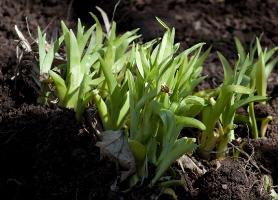Lily transplantation should be carried out systematically. This flower needs constant seating. It is recommended to do this at least once every three years. For a species like lily, this is the best growth period in one area. If you are late with a transplant, then there will be noticeably weaker flowering. This is a consequence of the fact that there are few minerals in the soil that are so necessary for the flower. In addition, there is a risk of developing diseases in the plant.
This perennial flower prefers loams. Therefore, a lily transplant should take into account these preferences. Of course, when growing, you can take other soil, but the main thing is that it be well fertilized with nutrients and have a slightly acid, but not alkaline reaction. The landing area should be slightly shaded, although the flower will feel good in the sun.

So, the question of when the lily transplant is most favorable remains relevant for many gardeners. The best time is the first decade of September. You can plant this flower in the spring. However, then this is best done immediately after the soil has thawed and warmed up a bit. Lily bulbs are planted in open ground after division. It is necessary to ensure that they do not have time to dry out. Storage of planting material is a little difficult. In order for the bulbs to remain viable for some time, they must be placed in moss or, somewhat easier, in moist sawdust. Only healthy bulbs without signs of rot or fungal infection are selected for planting.
In order for the lily transplant to be as successful as possible, it is very important not to forget about fertilizing the soil. It should contain in the right amount not only minerals, but also organic ones. Remember that in a new place the flower will grow for at least three years, so it should not lack nutrients. When planting lilies, it is recommended to add humus to the finished garden bed. The calculation of the amount of fertilizers is as follows: for 1 m 2 - one 5-liter bucket, 30 g of potassium nitrate and 50 g of superphosphate.
The last question remains,
how to plant lilies? So, the soil should be loamy and well fertilized. Transplantation of
garden lilies is carried out in the holes at a distance of approximately 30 cm from each other. If the plant variety is not large, then you can reduce it to 20 cm. If the planting is not in sandy soils, then do not forget that it is necessary to pour a layer of sand 3-5 cm thick at the bottom of the hole. It is more difficult to determine the depth. The best option is 3 onion heights. If a plant variety with creeping stems, then the depth is reduced, but if, on the contrary, the shoots are high, then they increase.
It is very important to consider the timing of transplanting lilies. The best time is the beginning of September, but not earlier. After planting, it is better to mulch the area with sawdust or peat. This helps maintain moisture and slows down weed growth. If sawdust acts as mulch, then nitrogen fertilizers must be introduced into the soil . For the winter, lilies are covered with a layer of fallen leaves.